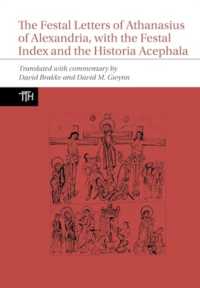Full Description
This engaging short work by a great American novelist addresses the then-controversial topic of interracial marriage. ""An Imperative Duty"" tells the story of Rhoda Aldgate, a young woman on the verge of marriage who has been raised by her aunt to assume that she is white but who is in fact the descendant of an African-American grandmother. The novel traces the struggles of Rhoda, her aunt, and Edward Olney, the aunt's physician and Rhoda's eventual suitor, to come to terms with the implications of Rhoda's ethnic heritage. Howells employs this stock situation to explore newly urgent questions of identity, morality, and social policy raised by 'miscegenation' in the new, post-Reconstruction situation to which he writes. The novel imagines interracial marriage sympathetically at a time when racist sentiment was on the rise, and does this is one of Howells' most aesthetically economical performances in the short novel form. The novel's appeal is increased by the primary source documents on nineteenth-century scientific race theory, contemporary attitudes toward race and miscegenation, and contemporary responses to the novel included in the appendices to this edition.
Contents
Acknowledgements
Introduction
W.D. Howells: A Brief Chronology
A Note on the Text
An Imperative Duty
First Installment: Chapters I-V: July 1891
Second Installment: Chapters VI-VII: August 1891
Third Installment: Chapters VIII-X: September 1891
Fourth Installment: Chapters XI-XIII: September 1891
Appendix A: Contemporary Reviews and Responses
Laurence Hutton, "Literary Notes," Harper's New Monthly Magazine (November 1891)
"The Color Line," New York Times (30 November 1891)
The Critic (16 January 1892)
"Novels of the Week," The Athenaeum (13 February 1892)
The Nation (25 February 1892)
From Anna Julia Cooper, A Voice from the South (1892)
From W.E.B. Du Bois, "As a Friend of the Colored Man," Boston Evening Transcript (24 February 1912)
Appendix B: The "Tragic Mulatta" in Literature
From Grace King, "The Little Convent Girl" (1893)
From Matt Crim, "Was It an Exceptional Case?" (1891)
W.D. Howells, "The Pilot's Story" (1860)
Appendix C: Interracial Marriage and the "Science" of Race
From Joseph-Arthur, Comte de Gobineau, Essay on the Inequality of Human Races (1853-55)
From J.C. Nott, Types of Mankind (1854)
From Frederick L. Hoffman, The Race Traits and Tendencies of the American Negro (1896)
Pace v. State of Alabama (1883)
From Henry W. Grady, "In Plain Black and White" (1885)
From Charles W. Chesnutt, "The Future American" (1900)
From W.E.B. Du Bois, "The Conservation of Races" (1897)
Appendix D: Appendix D:W.D. Howells's Theory of Realism—The "Editor's Study" Columns
May 1886 [Realism and Romance]
November 1886 [Aesthetics and Ethics]
April 1887 [Art,Truth, and Morality]
September 1887 [Realism and Democracy]
December 1887 [The Real and the Ideal Grasshopper]
March 1888 [Can Fiction Help the People It Depicts?]
December 1888 [Christmas Literature]
Select Bibliography








